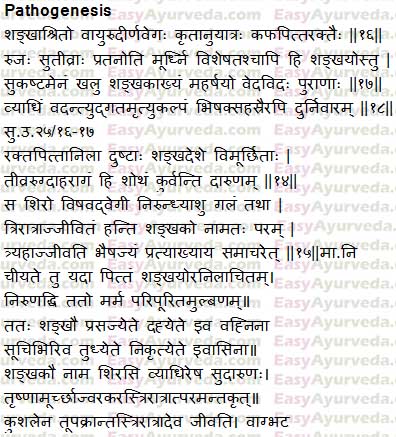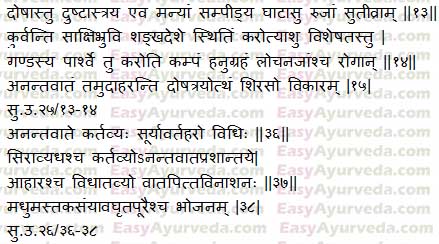Shankaka Shiroroga – Causes, Symptoms, Treatment
By Dr Raghuram Y.S. MD (Ay) & Dr Manasa, B.A.M.S
Shankaka is one of the types of headaches. It manifests in the temple region. Shanka means temple.
The headache in which the pain is predominantly present in the temple regions is called as shankaka.
Table of Contents
Causes
Specific causes have not been enlisted. We can infer the below mentioned factors as etiologies –
Wrong choices of foods and activities which tend to vitiate the doshas
All causative factors which are capable of causing headaches
Read – Migraine – Ayurvedic treatment, Herbs, Home Remedies
Pathogenesis
The vata gets vitiated following the consumption of the above said etiological factors.
The excited vata having intense velocity will provoke kapha, pitta and blood and carry them through the vessels and channels.
These doshas get settled in the temple regions of the head.
Severe and intolerable pain gets manifested in the temples..
This disease is called shankaka.
Alternative pathogenesis explained in Madhava Nidana
The amalgamation of vitiated pitta, blood and vata occurring in the temples, cause
- severe pain,
- burning sensation and
- dreadful swelling with redness in the temples
The swelling is as intense as poison. It quickly blocks the head and throat and kills the person within three days. The physician shall consider this headache as incurable. But if the person survives for more than three days after the onset of headache, the physician should treat it skillfully.
Read – Tension Headache Ayurvedic Treatment, Remedies, Tips, Herbs
Pathogenesis according to master Vagbhata
Due to excessive consumption of incompatible foods and activities, the pitta first gets aggravated. It gets lodged in the temples. Here the pitta contaminates the already accumulated vata and causes its aggravation. Both these doshas occupy all the vital regions and blocks their orifices. As a consequence the patient feels as if his temples are burning with fire. The pain is severe and intolerable. The person may feel pins and needles in the head.
Severe thirst, loss of consciousness and fever are manifested as complications. If this condition is treated in time by a wise and experienced physician, the patient will be fine in 3 days. Or else the disease has bad prognosis and is going to cause death within 3 days.
Read – Suryavarta Shiroroga – Causes, Symptoms, Treatment
Difference of opinions and similarities in the explanation of pathogenesis
Master Sushruta has included kapha among the causal doshas whereas master Madhava has not.
Master Sushruta has considered Vata as the predominant dosha in the causation of this headache. Master Madhava has considered blood as the predominant contaminant and master Vagbhata has stressed that pitta is the predominant dosha.
On the other hand all the authors have accepted
- the involvement of all the three doshas and blood in the pathogenesis
- that this headache has bad prognosis
- that death shall occur after three days
- if a wise and skilful physician implements proper interventions in these three days, the person can survive
Sanskrit Verse


Prognosis of Shankhaka
Shankaka headache is said to be
- difficult to treat
- of the nature of impending death or equivalent to death
- impossible to cure in spite of efforts of thousands of physicians to treat it
The temples are said to be marmas i.e. vital spots in the body which can cause immediate death. Since temples are delicate body structures, the headache occurring in these regions are very difficult to cure.
Probable modern correlation
The symptoms seen in shankaka may occur due to
- deformities / blocks in the venous sinuses of the brain
- deformities occurring in dural or basal blood vessels
- Thrombosis or impaction of clots in these arteries or
- hemorrhage occurring in the cranial blood vessels
All these may eventually lead to death in short time.
Cerebral hemorrhage may occur in the brain matrix or ventricles of the brain or due to rupture of an artery, arterioles, capillaries, aneurysm or venous sinuses. All these are called as intracranial hemorrhages.
Treatment
Shankaka has bad prognosis. A wise physician will have three days to skillfully manage the condition, help the patient, and prevent complications and death.
If the patient fortunately survives after 3 days effective treatments can be done.
Kshira Sarpi – the ghee extracted from milk should be used as nasal drops / errhines or oral consumption.
Jangala Rasa – food should be consumed along with meat soup prepared from the meat of animals and birds living in the desert like regions.
Snigdha ahara – food should be taken along with / mixed with ghee.
Lepas – the below mentioned pastes should be applied over the painful part of head / temples.
Shatavaryadi Lepa – paste of Asparagus racemosus, sesame, licorice, blue variety of lotus, Cynodon dactylon and Boerhavia diffusa.
Darvyadi lepa – paste of Berberis aristata, turmeric, Rubia cordifolia, bark of neem, vetiver and Prunus cerasoides.
Mahasugandha lepa – paste of Hemidesmus indicus / Pluchea lanceolata.
Shita parisheka / pradeha –
Sprinkling / showering using liquids prepared using coolant herbs like Vidarigandhadi, Kakolyaid or Utpaladi group of herbs should be done. Anointment with pastes of the same herbs is also beneficial.
Suryavarta nivaraka avapidana – the herbs used for errhine therapy in suryavarta headache should be used.
Shirovirehana – Head cleansing / purification
Powder of head cleansing herbs mentioned in the samshodhaniya and samshamaniya chapters should be used. They should be mixed with honey and oil and instilled. After this drops of mustard oil should be instilled in the nostrils.
Snehana, swedana, siramokshana –
Medicated fats for oleation should be given when the above said measures fails to subside the headache. Following this sudation should be administered. Later bloodletting in the form of venesection should be done. These measures will provide comprehensive cure to shankaka headache.
Medicines for Shiroroga From Sahasra Yoga Text Book
Mashadi Taila
Triphaladi Taila
Asanabilwadi Taila
Manjishtadi Taila
Bala Hathadi Taila
Bala Dhatryadi Taila
Tungadrunadi Taila
Amrutadi Taila
Kacchuradi Choorna (brihat)
Nasika Choorna
Korit Talam
Shirastoda Gutika
Villam Pacchotyadi Taila
Kayyonyadi Taila
Jati Manyaladi Taila
Click to Consult Dr Raghuram Y.S. MD (Ayu) – Skype







